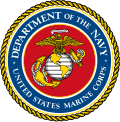History
Marines were present during the U.S. Expedition to Korea in 1871. [1] During the Korean War in 1950, the 1st Marine Division participated in the U.S. campaign. Marines were deployed to Korea at the request of General Douglas MacArthur, the U.S. Commander-in-Chief in the Far East, and fought in the Battle of Inchon and the Battle of Chosin Reservoir. [2]
Headquarters Marine Corps Forces Korea was activated on 1 June 1995 as part of Fleet Marine Force, Pacific (FMFPAC). [2] MARFORK is tasked with coordinating and planning all operational, training, and logistical issues related to Marines in South Korea during peacetime. In the event of a war, U.S. Marine Corps Forces, Pacific (MARFORPAC) will provide Marine Forces Korea with a full staff for military operations, and MARFORK would oversee the Korean theater of operations. The Commander of MARFORK is also the Commander of the Combined Marine Forces Command (COMCMFC), and is the U.S. Marine Corps representative to the head of the Republic of Korea Marine Corps (ROKMC), as well as representing the Commander of MARFORPAC. MARFORK assists and provides Marine capabilities to the Commander, U.S. Forces Korea and United Nations Command. [3]
Between 1995 [4] and at least 2001, [5] the commander of U.S. Marine Corps Forces, Pacific (MARFORPAC) was also the commander-designate of U.S. Marine Corps Forces, Korea (MARFORK). The title was nominally held by the commander of MARFORPAC, and he was represented in South Korea by a small staff. [4] In the event of a war, the MARFORPAC commander and much of his staff would relocate to South Korea and would form the Combined Marine Forces Command, together with the ROKMC leadership. [6]
This page is based on this
Wikipedia article Text is available under the
CC BY-SA 4.0 license; additional terms may apply.
Images, videos and audio are available under their respective licenses.

